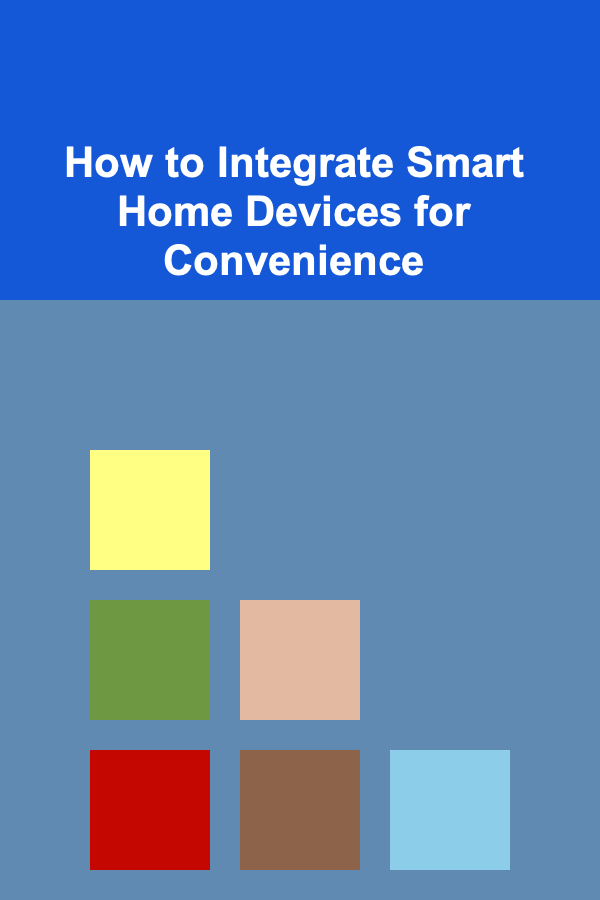
How to Integrate Smart Home Devices for Convenience
ebook include PDF & Audio bundle (Micro Guide)
$12.99$5.99
Limited Time Offer! Order within the next:

As technology continues to evolve, smart home devices are becoming increasingly prevalent in modern households. These gadgets not only provide convenience but also enhance security, energy efficiency, and overall comfort. This article will delve into how to integrate smart home devices effectively to maximize the benefits they offer while ensuring a seamless experience.
Understanding Smart Home Technology
Smart home technology refers to devices that connect to the internet and can be controlled remotely. This includes everything from light bulbs and thermostats to security cameras and appliances. Most smart home devices use wireless communication protocols such as Wi-Fi, Bluetooth, Zigbee, or Z-Wave.
Key Components of Smart Home Technology:
- Connectivity: Devices must connect to the internet via Wi-Fi or other methods.
- Automation: Many devices can perform tasks automatically based on triggers or schedules.
- Remote Control: Users can manage their devices from anywhere using smartphones or voice assistants.
Benefits of Smart Home Integration
Integrating smart home devices offers numerous advantages that go beyond mere convenience. Here are some of the primary benefits:
1. Enhanced Convenience
With smart devices, you can control your home environment from anywhere. Adjusting the thermostat, turning off lights, or checking camera feeds can all be done from your smartphone or through voice commands.
2. Improved Energy Efficiency
Smart thermostats and lighting systems can optimize energy usage, leading to lower utility bills. For instance, you can program your thermostat to adjust temperatures when you're not home.
3. Increased Security
Smart security systems offer real-time monitoring and alerts, giving homeowners peace of mind. Devices like smart locks, cameras, and motion sensors can deter intruders.
4. Customization and Personalization
Smart homes allow users to create personalized settings and routines, making daily life more enjoyable and efficient. You can customize lighting, temperature, and even music preferences.
Assessing Your Needs and Goals
Before diving into the world of smart home technology, it's essential to assess your personal needs and goals. Consider the following:
Identify Pain Points
What aspects of your daily life would you like to improve? Take note of tasks that are repetitive or inconvenient.
Set Clear Goals
Define what you hope to achieve with smart home integration. Is it increased security, energy savings, or simply convenience?
Budget Considerations
Determine how much you're willing to invest in smart home devices. Prices can range significantly based on features and brand.
Choosing the Right Smart Home Ecosystem
Selecting a compatible ecosystem is crucial for integrating multiple smart devices smoothly. Some popular ecosystems include:
1. Amazon Alexa
Amazon's Alexa ecosystem offers a wide range of devices and third-party integrations. It's user-friendly and supports various smart home brands.
2. Google Assistant
Google Assistant integrates seamlessly with Google services and numerous smart devices. Its voice recognition capabilities are robust, making it a popular choice.
3. Apple HomeKit
Apple's ecosystem is known for its security and privacy features. However, it has fewer compatible devices compared to Alexa and Google Assistant.
4. Samsung SmartThings
SmartThings supports a variety of devices and allows for comprehensive automation. It's great for users looking for flexibility.
Essential Smart Home Devices
Once you've selected an ecosystem, consider investing in these essential smart home devices:
1. Smart Thermostat
A smart thermostat learns your heating and cooling preferences over time, optimizing your energy usage and saving money.
2. Smart Lighting
Smart bulbs can be controlled remotely, adjusted for brightness, and programmed to change colors. They often work well with voice assistants.
3. Smart Security Cameras
These cameras provide real-time monitoring and alerts, allowing you to keep an eye on your property while away.
4. Smart Locks
Smart locks allow you to lock/unlock your doors remotely, set temporary access codes, and monitor entry activity.
5. Smart Plugs
Smart plugs let you control traditional devices remotely, providing a cost-effective way to integrate non-smart appliances.
Setting Up Your Smart Home Network
A solid foundation for your smart home begins with a reliable network. Follow these steps to set up your smart home network:
1. Choose a Reliable Router
Ensure your router has a strong signal and covers your entire home. Consider upgrading to a mesh network if needed.
2. Secure Your Network
Set a strong password for your Wi-Fi and enable network encryption to protect against unauthorized access.
3. Create a Dedicated Network for Smart Devices
If possible, create a separate network specifically for your smart devices. This adds an extra layer of security.
Integrating Devices with a Central Hub
Using a central hub can simplify control over various smart devices. Here's how to integrate them effectively:
1. Select a Suitable Hub
Choose a hub that supports the devices you plan to integrate. Popular options include SmartThings Hub, Wink Hub, and Amazon Echo Plus.
2. Connect Devices to the Hub
Follow the manufacturer's instructions to connect each device to the hub. This usually involves downloading an app and following setup prompts.
3. Organize Devices by Room
Creating room-based groups can make controlling devices more intuitive. For example, group all living room devices together for easier management.
Automating Your Smart Home
Automation enhances convenience by enabling devices to work together without manual intervention. Here's how to set up automations:
1. Create Routines
Most smart home ecosystems allow users to create routines. For example, you could set a "Good Night" routine that turns off all lights, locks the doors, and adjusts the thermostat.
2. Use Triggers
Set up triggers based on specific conditions, such as time of day or sensor activation. For example, lights could turn on automatically at sunset.
3. Scenarios and Scenes
Create scenes that adjust multiple devices at once. For example, a "Movie Night" scene could dim the lights and turn on your TV.
Ensuring Security and Privacy
The convenience of smart home devices comes with potential risks. Protect your home and data by following these best practices:
1. Regularly Update Firmware
Firmware updates often include security patches. Ensure all devices are updated regularly to mitigate vulnerabilities.
2. Enable Two-Factor Authentication
For accounts associated with smart devices, enable two-factor authentication to add an additional layer of protection.
3. Review Privacy Settings
Understand what data your devices collect and review privacy settings accordingly. You may want to limit data sharing with third parties.
Maintenance and Troubleshooting
Keeping your smart home devices running smoothly requires ongoing maintenance and troubleshooting. Here are some strategies:
1. Monitor Device Performance
Regularly check the functionality of your devices. If something isn't working as expected, investigate potential issues.
2. Clear Cache and Data
For smart home apps, clearing cache and data can resolve performance issues.
3. Reboot Devices as Needed
Sometimes a simple reboot is all it takes to fix connectivity problems.
Future Trends in Smart Home Technology
The smart home industry is evolving rapidly. Here are a few future trends to watch:
1. Increased Interoperability
Expect improvements in compatibility between different brands and devices, allowing for more flexible setups.
2. AI and Machine Learning
Smarter algorithms will enable devices to learn your habits and preferences more effectively.
3. Sustainability Features
Future devices will likely focus on energy efficiency and sustainability, helping you reduce your carbon footprint.
Conclusion
Integrating smart home devices can lead to a more convenient, efficient, and secure living environment. By understanding the technology, assessing your needs, choosing the right devices and ecosystem, and implementing automation, you can unlock the full potential of your smart home. As you embark on this journey, keep security and maintenance in mind to ensure a seamless and enjoyable experience. Embrace the future of living with smart home technology, and enjoy the myriad conveniences it brings to your everyday life.

How to Add Soundproofing to Your Existing Home Renovations
Read More
How to Create a Budget to Save for Your Investments
Read More
How to Create a Cozy Home with Budget-Friendly Textiles
Read More
How to Make Money as a Travel Photographer While Exploring
Read More
How to Make Your Home Party More Interactive for Guests
Read More
How to Plan for Retirement in Your 20s and 30s
Read MoreOther Products

How to Add Soundproofing to Your Existing Home Renovations
Read More
How to Create a Budget to Save for Your Investments
Read More
How to Create a Cozy Home with Budget-Friendly Textiles
Read More
How to Make Money as a Travel Photographer While Exploring
Read More
How to Make Your Home Party More Interactive for Guests
Read More